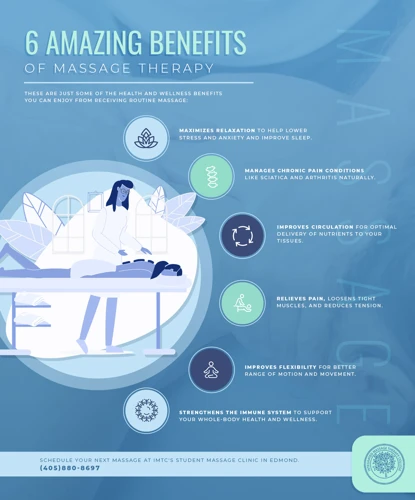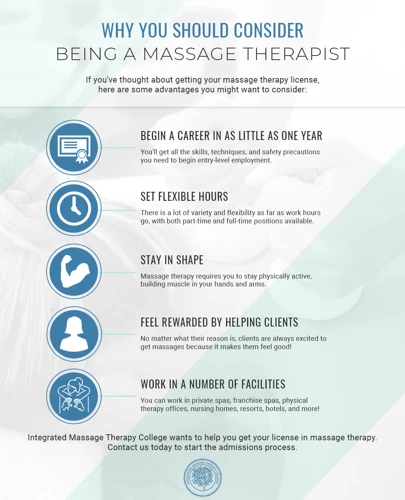Are you interested in becoming a massage therapist? If so, you may be wondering what do you learn in massage therapy school? Massage therapy school provides students with the knowledge and skills needed to practice massage therapy. From anatomy and physiology to therapeutic techniques, massage therapy school provides students with the education they need to become successful massage therapists. In this article, we will explore the different topics covered in massage therapy school, what to expect from your studies, and how to choose the right school for you.
Contents
Benefits of Massage Therapy

| Physical Benefits | Mental Benefits |
|---|---|
|
|
Massage Therapy has a range of benefits, both physical and mental. Physically, you can expect to experience a reduction in stress and anxiety, relaxation of muscles, reduction of muscle tension and soreness, reduction of pain, improvement in flexibility and range of motion, and reduction of heart rate and blood pressure. Mentally, you can expect to experience a calming of the nervous system, improved concentration and alertness, heightened mental clarity, increased creativity, greater ability to monitor stress signals, and heightened body awareness. To learn how to study massage therapy, explore the programs and courses offered at a massage therapy school near you.
What do You Learn in Massage Therapy School?

Anatomy and Physiology
Anatomy and physiology are the foundation of massage therapy. Students will learn the fundamentals of anatomy and physiology, including the structure and function of the human body and its systems. This is essential for understanding how massage can benefit the body and how to choose the best approach for each individual.
Massage Techniques
Massage therapy schools train students in a variety of massage techniques, including Swedish massage, deep tissue massage, sports massage, trigger point therapy, and lymphatic drainage. Students will learn how to properly apply these techniques to different parts of the body, as well as how to modify them for different individuals.
Kinesiology
Kinesiology is the study of human movement and how it affects the body. Massage therapy students will gain an understanding of how the body moves and how massage can be used to improve posture, balance, and flexibility. They will also learn how to use specific massage techniques to help alleviate pain and improve performance.
Pathology
Pathology is the study of diseases and disorders. Massage therapy schools will teach students about common medical conditions and how massage can be used to help alleviate symptoms. Students will learn to recognize when it is appropriate to refer a client to a medical professional for further evaluation and treatment.
Ethics
Massage therapy schools also teach students about the ethical considerations of the profession. This includes understanding the boundaries between massage therapy and other medical treatments, as well as the importance of client confidentiality.
Business Practices
Finally, massage therapy schools will teach students about the business aspects of the profession. This includes topics such as marketing, record keeping, billing, and customer service. Students will also learn how to set up and manage their own massage therapy business.
How to Study Massage Therapy
Research
Do your homework to learn about the different massage techniques and specialties, as well as licensing requirements in your state. Massage therapy is an ever-evolving field, so staying up to date on the latest advances and techniques is essential.
Online Learning
Take advantage of online resources such as websites, videos, and webinars to learn about massage therapy and its related topics. You can also find online courses that provide a deeper dive into the subject.
Hands-on Practice
Gain practical experience by practicing massage on friends, family, and volunteers. This will help you develop your skills, as well as get feedback on your technique.
Mentorship
Find a mentor who is experienced in the field and can provide guidance as you learn the ropes. A mentor can also offer insight into the massage therapy industry and help you develop your career.
Frequently Asked Questions
What kind of qualifications do I need to attend a Massage Therapy School?
Most massage therapy schools require a high school diploma or equivalent, as well as a valid massage therapy license. Many also require proof of a negative TB test, liability insurance, and updated CPR certification. Some schools also require a background check and drug screening. Additionally, many massage therapy schools require students to have prior experience in the field, such as a minimum number of hours of massage therapy practice.
How Long Does it Typically Take to Complete a Massage Therapy Program?
Completing a massage therapy program typically takes between 600 and 1,000 hours, depending on the school and program. Many massage therapy schools offer part-time and full-time programs to accommodate different schedules. Part-time programs typically last between one and two years, while full-time programs can be completed in as little as six months.
There are also accelerated programs available which allow students to complete the program in a shorter time-frame. These programs usually involve long hours of study and practice, and should not be undertaken lightly.
Once the program is completed, most states require massage therapists to become certified or licensed. This process often involves passing a written and practical exam and paying a fee. To maintain licensure, massage therapists may have to complete continuing education courses.
What topics does a typical massage therapy program cover?
- Anatomy – massage therapists need to understand the basic anatomy of the human body in order to properly assess, diagnose and treat clients.
- Physiology – this focuses on how the body functions and responds to certain treatments.
- Pathology – massage therapists must understand illnesses and diseases and how they affect the body in order to provide safe and effective treatments.
- Kinesiology – massage therapists must understand the movement of the body in order to properly assess, diagnose and treat clients.
- Clinical Massage – this involves the application of various massage techniques, such as Swedish massage, deep tissue massage, sports massage, and more.
- Business and Professional Ethics – this covers topics such as laws and regulations related to massage therapy, professional standards of practice, and more.
- Communication Skills – this focuses on how to effectively communicate with clients, as well as how to build strong client relationships.
Are there any internships or job opportunities for massage therapy students?
Yes, there are! Massage therapy schools offer a variety of internship and job opportunities for massage therapy students. Many employers look for massage therapy students who have completed a degree program in massage therapy and have the necessary skills and knowledge to provide quality massage services.
- Clinical Internships: Many massage therapy schools provide students with the opportunity to do clinical internships at local hospitals or clinics. This gives students the chance to learn the techniques of massage therapy and gain hands-on experience.
- Part-Time Positions: Some massage therapy schools offer part-time positions to massage therapy students. These positions allow students to work in a variety of settings, including spas, resorts, and medical offices. Students can also gain valuable skills and experience while working in these positions.
- Full-Time Positions: After completing their massage therapy degree, students can apply for full-time positions in various settings. These positions typically require a higher level of skill and knowledge than part-time positions.
- Self-Employment: Massage therapy students can also choose to start their own business. This can include freelance work, working in a private practice, or setting up a massage therapy studio. Self-employment provides students with the opportunity to build their own business, set their own hours, and take advantage of opportunities to specialize in certain areas of massage therapy.
No matter which path you choose, massage therapy schools can provide you with the tools and knowledge you need to succeed in the field of massage therapy.
Is financial aid available for students in massage therapy programs?
Yes! Many massage therapy schools offer financial aid and scholarships for eligible students.
- The federal government, state governments, and private organizations all offer financial aid for massage therapy programs.
- Some massage therapy schools have their own scholarship programs.
- Financial aid may include grants, loans, and work-study programs.
- The amount of financial aid available will vary depending on the school and your eligibility.
- Be sure to check with the school’s Financial Aid Office to find out more about available aid.
Additionally, some schools may offer tuition discounts or payment plans to help make massage therapy school more affordable. Be sure to ask your admissions advisor about any special offers or discounts that may be available.
Conclusion
Massage therapy school offers an abundance of opportunities to learn about the science and art of massage. With classes that range from anatomy and physiology to massage techniques and business principles, students gain a comprehensive knowledge of the massage therapy field. With such diverse education, massage therapy school can be a great starting point for those interested in pursuing a career in the field.

